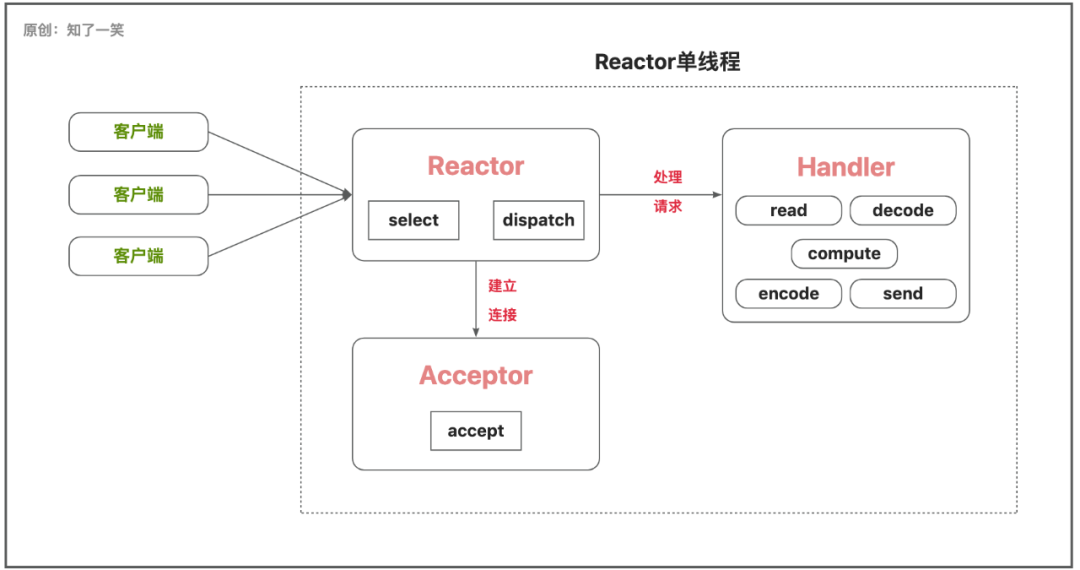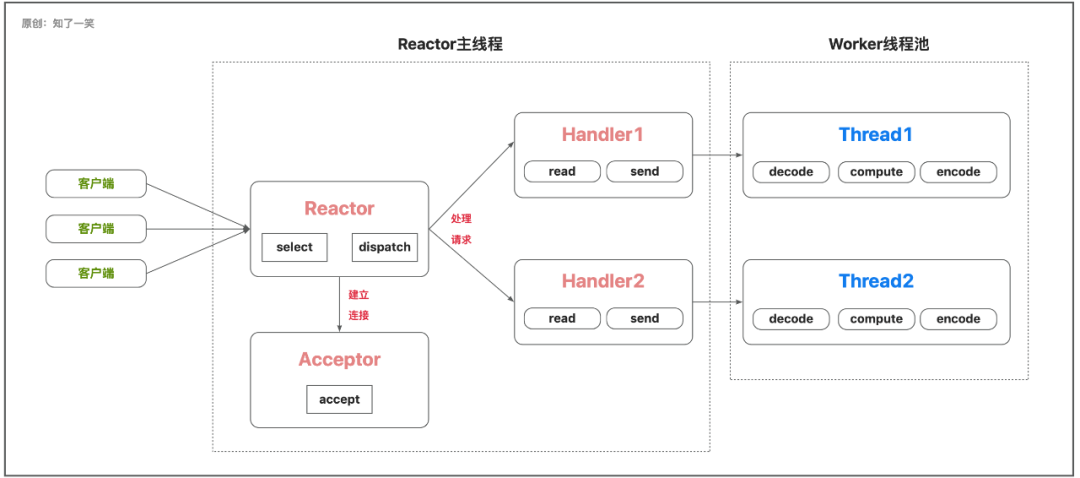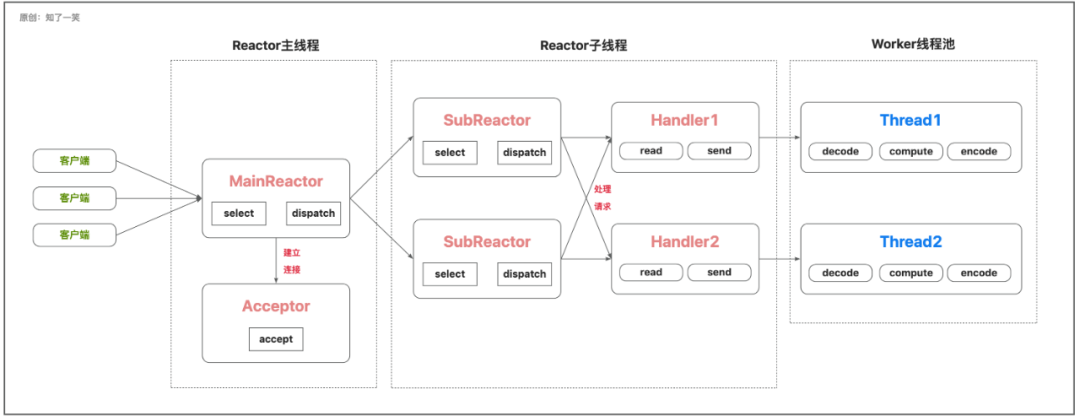

IO流中「线程」模型总结
source link: https://www.51cto.com/article/751386.html
Go to the source link to view the article. You can view the picture content, updated content and better typesetting reading experience. If the link is broken, please click the button below to view the snapshot at that time.

一、基础简介
在IO流的网络模型中,以常见的「客户端-服务端」交互场景为例;

客户端与服务端进行通信「交互」,可能是同步或者异步,服务端进行「流」处理时,可能是阻塞或者非阻塞模式,当然也有自定义的业务流程需要执行,从处理逻辑看就是「读取数据-业务执行-应答写数据」的形式;
Java提供「三种」IO网络编程模型,即:「BIO同步阻塞」、「NIO同步非阻塞」、「AIO异步非阻塞」;
二、同步阻塞
1、模型图解
BIO即同步阻塞,服务端收到客户端的请求时,会启动一个线程处理,「交互」会阻塞直到整个流程结束;

这种模式如果在高并发且流程复杂耗时的场景下,客户端的请求响应会存在严重的性能问题,并且占用过多资源;
2、参考案例
【服务端】启动ServerSocket接收客户端的请求,经过一系列逻辑之后,向客户端发送消息,注意这里线程的10秒休眠;
public class SocketServer01 {
public static void main(String[] args) throws Exception {
// 1、创建Socket服务端
ServerSocket serverSocket = new ServerSocket(8080);
// 2、方法阻塞等待,直到有客户端连接
Socket socket = serverSocket.accept();
// 3、输入流,输出流
InputStream inStream = socket.getInputStream();
OutputStream outStream = socket.getOutputStream();
// 4、数据接收和响应
int readLen = 0;
byte[] buf = new byte[1024];
if ((readLen=inStream.read(buf)) != -1){
// 接收数据
String readVar = new String(buf, 0, readLen) ;
System.out.println("readVar======="+readVar);
}
// 响应数据
Thread.sleep(10000);
outStream.write("sever-8080-write;".getBytes());
// 5、资源关闭
IoClose.ioClose(outStream,inStream,socket,serverSocket);
}
}【客户端】Socket连接,先向ServerSocket发送请求,再接收其响应,由于Server端模拟耗时,Client处于长时间阻塞状态;
public class SocketClient01 {
public static void main(String[] args) throws Exception {
// 1、创建Socket客户端
Socket socket = new Socket(InetAddress.getLocalHost(), 8080);
// 2、输入流,输出流
OutputStream outStream = socket.getOutputStream();
InputStream inStream = socket.getInputStream();
// 3、数据发送和响应接收
// 发送数据
outStream.write("client-hello".getBytes());
// 接收数据
int readLen = 0;
byte[] buf = new byte[1024];
if ((readLen=inStream.read(buf)) != -1){
String readVar = new String(buf, 0, readLen) ;
System.out.println("readVar======="+readVar);
}
// 4、资源关闭
IoClose.ioClose(inStream,outStream,socket);
}
}三、同步非阻塞
1、模型图解
NIO即同步非阻塞,服务端可以实现一个线程,处理多个客户端请求连接,服务端的并发能力得到极大的提升;

这种模式下客户端的请求连接都会注册到Selector多路复用器上,多路复用器会进行轮询,对请求连接的IO流进行处理;
2、参考案例
【服务端】单线程可以处理多个客户端请求,通过轮询多路复用器查看是否有IO请求;
public class SocketServer01 {
public static void main(String[] args) throws Exception {
try {
//启动服务开启监听
ServerSocketChannel socketChannel = ServerSocketChannel.open();
socketChannel.socket().bind(new InetSocketAddress("127.0.0.1", 8989));
// 设置非阻塞,接受客户端
socketChannel.configureBlocking(false);
// 打开多路复用器
Selector selector = Selector.open();
// 服务端Socket注册到多路复用器,指定兴趣事件
socketChannel.register(selector, SelectionKey.OP_ACCEPT);
// 多路复用器轮询
ByteBuffer buffer = ByteBuffer.allocateDirect(1024);
while (selector.select() > 0){
Set<SelectionKey> selectionKeys = selector.selectedKeys();
Iterator<SelectionKey> selectionKeyIter = selectionKeys.iterator();
while (selectionKeyIter.hasNext()){
SelectionKey selectionKey = selectionKeyIter.next() ;
selectionKeyIter.remove();
if(selectionKey.isAcceptable()) {
// 接受新的连接
SocketChannel client = socketChannel.accept();
// 设置读非阻塞
client.configureBlocking(false);
// 注册到多路复用器
client.register(selector, SelectionKey.OP_READ);
} else if (selectionKey.isReadable()) {
// 通道可读
SocketChannel client = (SocketChannel) selectionKey.channel();
int len = client.read(buffer);
if (len > 0){
buffer.flip();
byte[] readArr = new byte[buffer.limit()];
buffer.get(readArr);
System.out.println(client.socket().getPort() + "端口数据:" + new String(readArr));
buffer.clear();
}
}
}
}
} catch (Exception e) {
e.printStackTrace();
}
}
}【客户端】每隔3秒持续的向通道内写数据,服务端通过轮询多路复用器,持续的读取数据;
public class SocketClient01 {
public static void main(String[] args) throws Exception {
try {
// 连接服务端
SocketChannel socketChannel = SocketChannel.open();
socketChannel.connect(new InetSocketAddress("127.0.0.1", 8989));
ByteBuffer writeBuffer = ByteBuffer.allocate(1024);
String conVar = "client-hello";
writeBuffer.put(conVar.getBytes());
writeBuffer.flip();
// 每隔3S发送一次数据
while (true) {
Thread.sleep(3000);
writeBuffer.rewind();
socketChannel.write(writeBuffer);
writeBuffer.clear();
}
} catch (Exception e) {
e.printStackTrace();
}
}
}四、异步非阻塞
1、模型图解
AIO即异步非阻塞,对于通道内数据的「读」和「写」动作,都是采用异步的模式,对于性能的提升是巨大的;

这与常规的第三方对接模式很相似,本地服务在请求第三方服务时,请求过程耗时很大,会异步执行,第三方第一次回调,确认请求可以被执行;第二次回调则是推送处理结果,这种思想在处理复杂问题时,可以很大程度的提高性能,节省资源:
2、参考案例
【服务端】各种「accept」、「read」、「write」动作是异步,通过Future来获取计算的结果;
public class SocketServer01 {
public static void main(String[] args) throws Exception {
// 启动服务开启监听
AsynchronousServerSocketChannel socketChannel = AsynchronousServerSocketChannel.open() ;
socketChannel.bind(new InetSocketAddress("127.0.0.1", 8989));
// 指定30秒内获取客户端连接,否则超时
Future<AsynchronousSocketChannel> acceptFuture = socketChannel.accept();
AsynchronousSocketChannel asyChannel = acceptFuture.get(30, TimeUnit.SECONDS);
if (asyChannel != null && asyChannel.isOpen()){
// 读数据
ByteBuffer inBuffer = ByteBuffer.allocate(1024);
Future<Integer> readResult = asyChannel.read(inBuffer);
readResult.get();
System.out.println("read:"+new String(inBuffer.array()));
// 写数据
inBuffer.flip();
Future<Integer> writeResult = asyChannel.write(ByteBuffer.wrap("server-hello".getBytes()));
writeResult.get();
}
// 关闭资源
asyChannel.close();
}
}【客户端】相关「connect」、「read」、「write」方法调用是异步的,通过Future来获取计算的结果;
public class SocketClient01 {
public static void main(String[] args) throws Exception {
// 连接服务端
AsynchronousSocketChannel socketChannel = AsynchronousSocketChannel.open();
Future<Void> result = socketChannel.connect(new InetSocketAddress("127.0.0.1", 8989));
result.get();
// 写数据
String conVar = "client-hello";
ByteBuffer reqBuffer = ByteBuffer.wrap(conVar.getBytes());
Future<Integer> writeFuture = socketChannel.write(reqBuffer);
writeFuture.get();
// 读数据
ByteBuffer inBuffer = ByteBuffer.allocate(1024);
Future<Integer> readFuture = socketChannel.read(inBuffer);
readFuture.get();
System.out.println("read:"+new String(inBuffer.array()));
// 关闭资源
socketChannel.close();
}
}五、Reactor模型
1、模型图解
这部分内容,可以参考「Doug Lea的《IO》」文档,查看更多细节;
1.1 Reactor设计原理
Reactor模式基于事件驱动设计,也称为「反应器」模式或者「分发者」模式;服务端收到多个客户端请求后,会将请求分派给对应的线程处理;

Reactor:负责事件的监听和分发;Handler:负责处理事件,核心逻辑「read读」、「decode解码」、「compute业务计算」、「encode编码」、「send应答数据」;
1.2 单Reactor单线程

【1】Reactor线程通过select监听客户端的请求事件,收到事件后通过Dispatch进行分发;
【2】如果是建立连接请求事件,Acceptor通过「accept」方法获取连接,并创建一个Handler对象来处理后续业务;
【3】如果不是连接请求事件,则Reactor会将该事件交由当前连接的Handler来处理;
【4】在Handler中,会完成相应的业务流程;
这种模式将所有逻辑「连接、读写、业务」放在一个线程中处理,避免多线程的通信,资源竞争等问题,但是存在明显的并发和性能问题;
1.3 单Reactor多线程

【1】Reactor线程通过select监听客户端的请求事件,收到事件后通过Dispatch进行分发;
【2】如果是建立连接请求事件,Acceptor通过「accept」方法获取连接,并创建一个Handler对象来处理后续业务;
【3】如果不是连接请求事件,则Reactor会将该事件交由当前连接的Handler来处理;
【4】在Handler中,只负责事件响应不处理具体业务,将数据发送给Worker线程池来处理;
【5】Worker线程池会分配具体的线程来处理业务,最后把结果返回给Handler做响应;
这种模式将业务从Reactor单线程分离处理,可以让其更专注于事件的分发和调度,Handler使用多线程也充分的利用cpu的处理能力,导致逻辑变的更加复杂,Reactor单线程依旧存在高并发的性能问题;
1.4 主从Reactor多线程

【1】 MainReactor主线程通过select监听客户端的请求事件,收到事件后通过Dispatch进行分发;
【2】如果是建立连接请求事件,Acceptor通过「accept」方法获取连接,之后MainReactor将连接分配给SubReactor;
【3】如果不是连接请求事件,则MainReactor将连接分配给SubReactor,SubReactor调用当前连接的Handler来处理;
【4】在Handler中,只负责事件响应不处理具体业务,将数据发送给Worker线程池来处理;
【5】Worker线程池会分配具体的线程来处理业务,最后把结果返回给Handler做响应;
这种模式Reactor线程分工明确,MainReactor负责接收新的请求连接,SubReactor负责后续的交互业务,适应于高并发的处理场景,是Netty组件通信框架的所采用的模式;
2、参考案例
【服务端】提供两个EventLoopGroup,「ParentGroup」主要是用来接收客户端的请求连接,真正的处理是转交给「ChildGroup」执行,即Reactor多线程模型;
@Slf4j
public class NettyServer {
public static void main(String[] args) {
// EventLoop组,处理事件和IO
EventLoopGroup parentGroup = new NioEventLoopGroup();
EventLoopGroup childGroup = new NioEventLoopGroup();
try {
// 服务端启动引导类
ServerBootstrap serverBootstrap = new ServerBootstrap();
serverBootstrap.group(parentGroup, childGroup)
.channel(NioServerSocketChannel.class).childHandler(new ServerChannelInit());
// 异步IO的结果
ChannelFuture channelFuture = serverBootstrap.bind(8989).sync();
channelFuture.channel().closeFuture().sync();
} catch (Exception e){
e.printStackTrace();
} finally {
parentGroup.shutdownGracefully();
childGroup.shutdownGracefully();
}
}
}
class ServerChannelInit extends ChannelInitializer<SocketChannel> {
@Override
protected void initChannel(SocketChannel socketChannel) {
// 获取管道
ChannelPipeline pipeline = socketChannel.pipeline();
// 编码、解码器
pipeline.addLast(new StringDecoder(CharsetUtil.UTF_8));
pipeline.addLast(new StringEncoder(CharsetUtil.UTF_8));
// 添加自定义的handler
pipeline.addLast("serverHandler", new ServerHandler());
}
}
class ServerHandler extends ChannelInboundHandlerAdapter {
/**
* 通道读和写
*/
@Override
public void channelRead(ChannelHandlerContext ctx, Object msg) throws Exception {
System.out.println("Server-Msg【"+msg+"】");
TimeUnit.MILLISECONDS.sleep(2000);
String nowTime = DateTime.now().toString(DatePattern.NORM_DATETIME_PATTERN) ;
ctx.channel().writeAndFlush("hello-client;time:" + nowTime);
ctx.fireChannelActive();
}
@Override
public void exceptionCaught(ChannelHandlerContext ctx,Throwable cause) throws Exception {
cause.printStackTrace();
ctx.close();
}
}【客户端】通过Bootstrap类,与服务器建立连接,服务端通过ServerBootstrap启动服务,绑定在8989端口,然后服务端和客户端进行通信;
public class NettyClient {
public static void main(String[] args) {
// EventLoop处理事件和IO
NioEventLoopGroup eventLoopGroup = new NioEventLoopGroup();
try {
// 客户端通道引导
Bootstrap bootstrap = new Bootstrap();
bootstrap.group(eventLoopGroup)
.channel(NioSocketChannel.class).handler(new ClientChannelInit());
// 异步IO的结果
ChannelFuture channelFuture = bootstrap.connect("localhost", 8989).sync();
channelFuture.channel().closeFuture().sync();
} catch (Exception e){
e.printStackTrace();
} finally {
eventLoopGroup.shutdownGracefully();
}
}
}
class ClientChannelInit extends ChannelInitializer<SocketChannel> {
@Override
protected void initChannel(SocketChannel socketChannel) {
// 获取管道
ChannelPipeline pipeline = socketChannel.pipeline();
// 编码、解码器
pipeline.addLast(new StringDecoder(CharsetUtil.UTF_8));
pipeline.addLast(new StringEncoder(CharsetUtil.UTF_8));
// 添加自定义的handler
pipeline.addLast("clientHandler", new ClientHandler());
}
}
class ClientHandler extends ChannelInboundHandlerAdapter {
/**
* 通道读和写
*/
@Override
public void channelRead(ChannelHandlerContext ctx, Object msg) throws Exception {
System.out.println("Client-Msg【"+msg+"】");
TimeUnit.MILLISECONDS.sleep(2000);
String nowTime = DateTime.now().toString(DatePattern.NORM_DATETIME_PATTERN) ;
ctx.channel().writeAndFlush("hello-server;time:" + nowTime);
}
@Override
public void channelActive(ChannelHandlerContext ctx) throws Exception {
ctx.channel().writeAndFlush("channel...active");
}
@Override
public void exceptionCaught(ChannelHandlerContext ctx,Throwable cause) throws Exception {
cause.printStackTrace();
ctx.close();
}
}六、参考源码
编程文档:
https://gitee.com/cicadasmile/butte-java-note
应用仓库:
https://gitee.com/cicadasmile/butte-flyer-parentRecommend
About Joyk
Aggregate valuable and interesting links.
Joyk means Joy of geeK